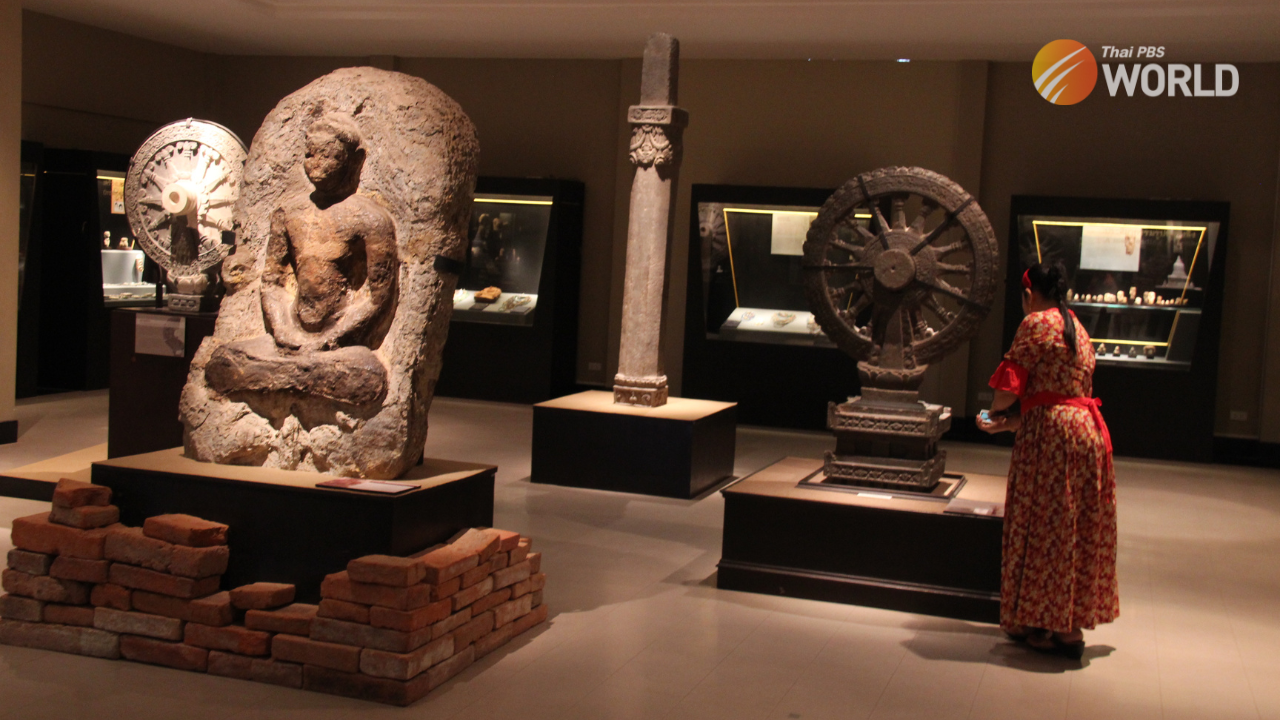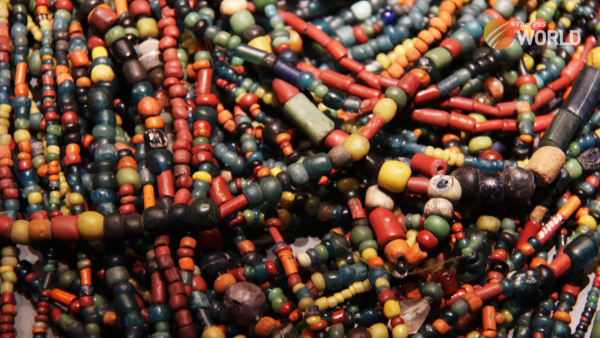
A visitor takes a close look at the Dharmachakra Wheel at U Thong National Museum in Suphan Buri. (Photo by Phoowadon Duangmee)
Think of Suphan Buri, and your mind probably conjures up images of endless rice paddies, water buffaloes chewing the cud mindfully, small-town charm, country music and farmers with a unique dialect and a humorous outlook on life. But while these are indeed all common to the province, Thailand’s rural legend has more to share with weekenders and culture and history enthusiasts.
Thirty kilometres south of downtown Suphan Buri, the U Thong National Museum is one of the best museums in the country. Established in 1966, two modern buildings painted vanilla white beckon art historians, archaeologists, goldsmiths, writers and the like-minded for the finest collection of the Dvaravati arts excavated from the ancient city of U Thong.
The religious arts and artefacts found in and around the ancient moated city of U Thong led academics to believe that U Thong, instead of Nakhon Pathom, was the first place where Buddhism was introduced to Thailand. It is also believed to have been the centre of Buddhism and culture and an international marine trade port about 2,500 to 3,000 years ago.

Take a left turn on the second floor, and you can see the exhibition hall showcasing prehistoric and historic artefacts found in the ancient city of U thong. The highlight is the terracotta tablet that portrays three Buddhist monks carrying their alms bowls. This piece of clay is considered the oldest piece of Buddhist art influenced by India ever found in Thailand. The delicate pattern of the flowing robes conjures up a real sense of the breeze and the walking pace of those three monks.
Other artefacts include stone Dharma wheel sculptures, bronze Buddha images, earthen Buddha images, earthen sculptures, beads, ornaments, tools, architectural remains, and stucco patterns. The wheel of the law – also known as the wheel of dharma and Dharmachakra – with the shrine and the stone pillar, in particular, is considered Thailand’s only masterpiece of antiquity.
“This set of the Wheels of the Law has a rectangular supporting base and an eight-edged pillar. It is very valuable because it is the only complete set found in perfect condition in Thailand,” a museum officer tells a group of visitors. “Dharmachakra with protective or beneficent motifs and deer represent Buddha’s first sermon in Benares. We are extremely fortunate to have excavated and display this piece from U Thong ancient city.”

Made of stone and crafted by artisans sometime between the seventh and the eighth centuries, the wheel of law measures around 90 by 130 centimetres. The artisans neatly fashioned the spokes and engraved a lotus flower on its base. It is the only Dharmachakra found in Thailand to come with a rectangular supporting base and an eight-edged pillar. On the top is a carved bunch of flowers, while the lower part is carved in the image of lotus flowers and swans within the rectangular frame.
Every bit as splendid as the wheel of the law is the Seated Preaching Buddha image, which presides over the centre of the exhibition hall.
Part of the fabled Suvarnabhumi civilisation (the “Land of Gold” to the east of India), the ancient city of U Thong was an important city during the Dvaravati period (seventh – eleventh centuries). Traders, sailors, and Buddhist and Hindu teachers visited late in the millennium to make their fortunes and spread their teachings.

“The Sanskrit inscription engraved in copper is evidence that ancient people in this area were influenced by Indian culture. Roman coins and other old coins from China and Arabia are excellent archaeological indicators of ancient trade as they often point to an ancient kingdom, place and the time they were created. Native coins also found here bear images of a conch and the sun. These coins are evidence that U Thong was an international marine trade hub,” explained the energetic officer.
One of the artefacts in perfect condition is Gutu or Chandra Sala, a terracotta slab in the form of a window frame or arch. It is part of the temple superstructure of ancient Indian architecture representing paradise where gods and goddesses live. The face in the window motif has thick facial features characteristic of Dvaravati sculptures, curly hair, and unalome on the forehead suggesting a combination of local and Indian art.
The display of beads made of gold, baked coloured clay, Carnelian stones and accessories like earrings and pendants are quite popular with female visitors. The sophisticated technique used to produce those accessories represents U Thong as a commercial hub as well as the fine craftsmanship of that era.

IF YOU GO
U Thong National Museum opens Wednesdays through Sundays, from 9.00 am-4.00 pm. Call (035) 551 040 or (035) 551 02.

